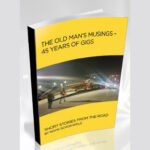Autobiography, corporate history, theatre history, memoir—the new book, A Theatre Project, by Richard Pilbrow, is as hard to classify as Pilbrow himself. Best known as a lighting designer, Pilbrow has also served as a ground-breaking theatre consultant. He’s also produced theatre, film and TV and was a projection designer before there was even a recognized craft as such.
Pilbrow also is an accomplished author whose works include Stage Lighting and Stage Lighting Design: The Art, the Craft, the Life, two books that are familiar to almost every undergraduate lighting student.
Perhaps his new book’s subtitle does a good job of explaining the scope: Triumph, Disaster and Renewal that Changed Stage Lighting, Sound and the Shape of Theatre, but even that doesn’t tell the potential reader the rich, engaging and insightful journey that Pilbrow has crafted inside.
The 486 pages are jam-packed with wonderful stories and store a visual feast with over 500 illustrations. It’s written like a great conversation, with the insight and personal asides that make the read fun and memorable.
Pilbrow has crossed paths with a veritable Who’s Who of theatrical standouts, and he shares this rich history with the reader, filling the pages with anecdotes and stories with his easy writing style. What makes the book somewhat unique and adds wonderful depth is that Pilbrow also lets a lot of his collaborators speak in the book, offering their views and perspectives on the shared journey.
Pilbrow’s career path is a fascinating one. He fills the book with a chronological history, of not just himself, but with the stories behind many theatrical milestones and productions he was part of. It’s true that you don’t do theatre alone, and Pilbrow has done a great job of giving credit where credit is due for his successes. He writes of his friendships and collaborations with an amazing array of designers and directors including Tony Walton, Robert Ornbo, David Collison, Jean Rosenthal, Tharon Musser, Boris Aronson and Hal Prince, as well as a long collaboration with Sir Laurence Olivier.
A Theatre Project is, at its core, an autobiography, but it is also the story of a company, Theatre Projects. Founded by Pilbrow in 1957 as lighting equipment rental company that offered lighting design services, both Theatre Projects and Pilbrow share similar upstart beginnings that followed unmarked paths through theatre history. Theatre Projects, today a world-renowned theatre consulting firm, was a pioneer of the discipline itself, and here Pilbrow shares the innovations, the incredible collaborations and also the frustrations of the company’s growth, missteps and triumphs. I found it particular insightful that Pilbrow has tied this autobiography of his design career with the historical biography of Theatre Projects because they are intrinsically interrelated.
Pilbrow’s life has had many acts, but perhaps it is his joy of innovation and passion for theatre that is most engaging for the readers. I feel that Pilbrow has captured what a life in the theatre is as a designer and a collaborator. Like his other writings, A Theatre Project is extremely informative and yet very personal. Pilbrow’s strength as a writer is his ability to inform but yet make readers feel as if only they are privy to the conversation as he shares his personal thoughts and experiences. A Theatre Project is highly recommended.
Pilbrow was also kind enough to answer a few questions for us about writing the book itself.
A Theatre Project: The Backstory
PLSN: Tell me about the process of bringing this all together…
Richard Pilbrow: I began the project back in 2006. The idea gradually grew that the Theatre Projects’ story was an unusual one. Not too many upstart companies have lasted in our business over 50 years. I’d begun as a totally green ASM in my first-ever job and was now working around the world, designing theatres.
At the same time, I suppose, I lived with a sense of frustration that even after 50 years so few people actually knew what the theatre design consultant actually did. Also, TPC today is very successful, but the company had only survived and grown thanks to so many amazingly dedicated, talented individuals who’d been in the company over the years. I wanted to remember them and pay tribute to them.
Next, I thought about what a period of extraordinary change we had lived through. Theatre technology, lighting, sound, video, stagecraft had changed so much. The theatre technology industry had exploded exponentially. This seemed a good story.
What was the most surprising thing you found or took away from the whole process of writing this book?
I suppose the self-evident thing is how small events accumulate. One serendipitous meeting that leads to another. It’s hard to understand that, in my 20s, I knew so little, but made it up as I went along. Ignorance really was bliss. But it was meetings and people—each and everyone led to something else. I suppose in my naiveté I thought I was responsible for all this stuff, but so much stemmed from these delightful and often almost accidental meetings, events and people.
What was it like working with David Collison on the book?
I’d talked with David from the outset. He had played such a pivotal role, both in his world of sound and, during the ghastly 1980s, as such a great businessman (to his complete surprise) at TPC and, of course, as a dear friend throughout. He helped do a lot of the interviews for the book and also read and re-read the book throughout the development as well as contributed to it.
What is next for you?
I’ve built a website, www.atheatreproject.com, in part to promote the book, but also to encourage people to add their stories, reactions and remembrances. In my spare time I’m turning to writing a book on theatre architecture that has been percolating for many years. There really isn’t a good modern book on the subject.


